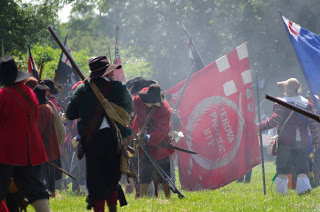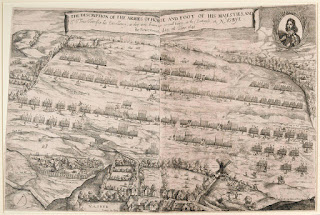So what were the Associations, and give me a reading list...
During the Wars, Parliament devolved local government to local Associations of counties where it held sway. These local Associations raised money, provided supplies and men for Parliament's great field army, which was under the command of the Earl of Essex. Each Association also raised its own army, which was responsible for garrisoning towns, protecting the borders of their Association, and they were also called upon to augment Essex's force. Some also went about their own campaigning.
The Association Armies were*:
- The Midlands Association, covering predominantly Warwickshire, Derbyshire, Staffordshire and Leicestershire. A slightly complicated affair, there were briefly two Midland Association armies. Initially commanded by Lord Brooke, then Sir John Gell took command after Brooke's death at Lichfield.
- Cheshire is a little different (it still is a little different, I can say that having been born in the county): not specifically called an Association, it could almost be described as the North Midlands Association as it covered Cheshire, Shropshire, and bits of Lancashire and Staffordshire. Commanded by Sir William Brereton
- The Western Association is a complicated picture. There was an army in what we would now call the south west covering Cornwall, Devon, Gloucestershire, Dorset, Somerset and Bristol. Waller's Western Association Army drawing additional regiments from Hampshire, Berkshire and Wiltshire. Commanded by Sir William Waller.
- The Southern Association drawing men from Surrey, Hampshire, Sussex and the Kent Trained Bands. Commanded by Sir William Waller after the loss of his Western Association army.
- The Northern Association was primarily built around Parliament's Yorkshire supporters, it also recruited men from Northumberland, Cumbria, bits of Lancashire and Lincolnshire. Commanded by Lord Ferdinando Fairfax
- The Eastern Association possibly the most famous of the all of the Association Armies. The Eastern Association drew its men from Essex, Suffolk, Norfolk, Cambridge and Hertford; many of the regiments would be subsumed into the 'Newly Modelled' Army. The Eastern Association was commanded by the Earl of Manchester.
The Midlands Association, The Northern Association: so far I haven't found any decent published material specifically about these Associations. Here be a gap in the market!
Cheshire: whilst there are a number of volumes that look at Sir William Brereton (mostly his letters), there is a stand out book on his Army. "More Like Lions Than Men" (Helion) by Andrew Abram. Combining narrative and regimental detail, this should be on everyone's shelf regardless of whether they are building Brereton's Cheshire Army.
The Western Association: a very detailed look at the Western forces is covered by Stuart Peachey and Alan Turton, initially intended to be a companion volume (almost) to their "Old Robin's Foot".
Initially planned as a 3 part "War in the West" series, only part 1 has surfaced. Produced as an 8 volume A5 pamphlet 'book', "The Fall of the West" (Stuart Press) runs to 852 pages and covers the period August 1642 to October 1643.
Stuart Press really need to reset the typeface, commission better maps, include some relevant photos and reprint the whole thing as a one volume hardback book. I'd buy it. Brief narrative of events, contemporary documents and officer lists for all of the western regiments and those who were 'left behind' by Essex and Waller.
Waller's Western Association Army gets a good narrative in Laurence Spring's "The Campaigns of Sir William Waller 1642-1645" (Helion), which also crosses over into...
The Southern Association: Waller's Southern Army gets the "Old Robin's Foot" treatment by Laurence Spring in "Waller's Army, The Regiments of Sir William Waller's Southern Association" (Pike & Shot Society).
The Eastern Association: Laurence Spring covers the Earl of Manchester's Eastern Association with two volumes, through to the rise of Cromwell, and the creation of the 'Newly Modelled' Army.
For narrative see "Campaigns of the Eastern Association, The Rise of Oliver Cromwell 1642-1645" (Helion).
For regimental detail and officer lists "The Army of the Eastern Association, Officers and Regiments" (Pike & Shot Society).
Neal Gray's "Europe Had No Better Soldiers. The Army of the Eastern Association and the York Campaign 1644" (Partizan Press) provides a narrative of the formation of the Army, and its role at Marston Moor. Extensive appendices documenting the order of battle at Marston Moor, and a number of transcribed documents relating to the Army, and also Marston Moor.
* this is a very simplified description of the geo-political landscape and history of the Associations. The question 'who/what were the Parliamentarian Associations?' could be the basis of a PhD thesis, and follow up Helion title.
Suppliers:
Please note, whilst I do occasionally get sent books to review, I bought all of the above volumes with my own money. Nor do I get any commission for recommending any reading materials...
If you enjoyed reading this, or any of the other posts, please consider supporting the blog. Thanks.











.jfif)








Excellent Mike. I never previously realised the distinction between the Midlands and Northern Associations, given they were both pretty much up against Newcastle. But they are the gap in the market!
ReplyDeleteSurprised that they haven't been researched to the same depth as Cheshire, or Eastern Association. Parliamentarian records are usually much better preserved, and more numerous, than Royalist records.
DeleteInteresting read. Did the Royalists use something akin to the Association system? And how about the Covenanters and the Confederates?
ReplyDeleteThanks.
DeleteRoyalists, appear to have raised their regiments along some old Trained Band regional organisation, but mostly raised by landowners 'persuading' their tenants to fight for them.
Covenanters, quite similar to Parliament, albeit a system based upon presbytery raising of regiments rather than political administrations (i.e. Associations). Each presbytery had a responsibility to raise and equip bodies of men.
Confederates it appears that landowners raised units (akin to the Royalists). Massive over simplification I'm afraid. Hope that helps.
I found the Midland Association a little bit confusing. On one side, you have the association which was set up by Lord Brooke and covered the Warwickshire, the West Midlands, Staffordshire and later on the Welsh Border.
ReplyDeleteI know Gell was in charge for Hopton Heath, but this army seems to have then been taken over by Basil Fielding, Earl of Denbigh. This army was then fighting at Tipton in 1644. I'm not sure exactly what happened to it after the Marston Moor campaign. Middleton and Mytton seem to have become independent commanders operating on the Welsh borders. Peter Young lists both of them as operating under Denbigh in June 1644 (Marston Moor - Appendix 2, note 25).
On the East Midlands side, Ballard was in charge for the 1st siege of Newark leading men from Lincolnshire, Nottinghamshire and Derbyshire.
He was replaced by Meldrum who gathered men from all across the East Midlands and borrowed 3 regiments from the Eastern Association for the 2nd siege of Newark.
After the relief of Newark, the Eastern side of the Midlands Association seems to have collapsed. Meldrum went North to join the Fairfax's in time for the Battle of Selby and stayed there for the siege of Scarborough. Part of the the Midlands forces turn up again at Naseby, some at the storm of Shelford Manor and others at the fight at Rowton Heath but there doesn't seem to be a unified command structure.
Saying that the Midland Association is complicated, is an understatement. I imagine that because they had Royalist threats/targets on so many fronts is the reason that they are complicated. Throw into the mix Brereton's Cheshire Army and it does begin to make a bit more sense.
Delete